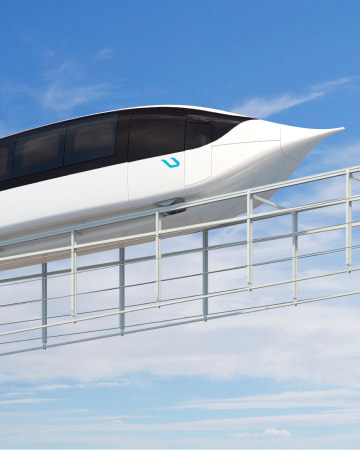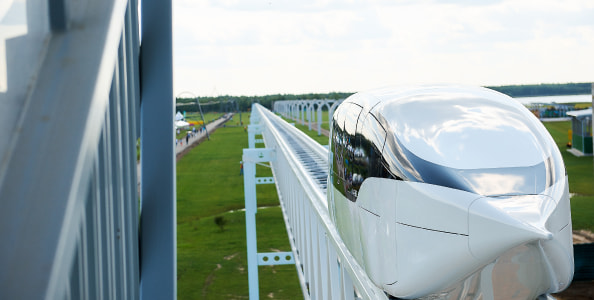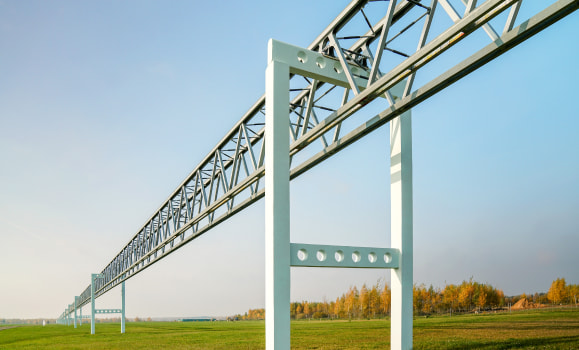High-speed transportation


uST high-speed transportation and infrastructure solutions
Speed
Comfortable transport communication at speeds of up to 500 km/h
Efficiency
Five times more energy efficient than air transportation
Safety
There is no risk of collision with foreign objects
Performance
The uST complex can service up to 100 million passengers per year
Application areas of uST high-speed complexes
Inter-city communication


International transportation


Comparison with other modes of high-speed transport
uST
Air transport
Maglev
Speed, km/h
500
960
430
Energy consumption for traveling, kWh/passenger/ 1000 km
55,7
250
99
Speed, km/h
uST
500
Air transport
960
Maglev
430
Energy consumption for traveling, kWh/passenger/ 1000 km
uST
55,7
Air transport
250
Maglev
99
How quickly will the uST complex and other vehicles perform transportation on these routes?
* The data for air transport are specified taking into account check-in and passing through other pre-flight and post-flight procedures
Advantages of uST high-speed complex
Eco-friendliness
The uST transport is distinguished by its minimal environmental impact and is suitable even for regions with strict environmental requirements. Due to the arrangement of routes on the second level, land acquisition is minimized. uST solutions do not disturb the terrain, preserve fertile soils, biogeocenosis and biodiversity of adjacent areas. String-rail overpasses do not interfere with the natural movement of ground and surface water and do not cross the migration paths of animals


Affordability
The cost of building a high-speed uST complex is determined by the terrain, the height of supports, the number and specificity of infrastructure facilities, and the total length of the route. Meanwhile, the average capital costs for the implementation of the uST high-speed complex are lower than for alternative types of elevated transport. The cost of transportation is also lower than that of an airplane, high-speed railroad, magnetic cushion train due to high energy efficiency. The aerodynamic drag coefficient Cx, for example, of a six-seat rail electric vehicle uFlash is 0.06. In terms of conventional liquid fuel: one such uPod will save about 20 thousand tons of fuel over 25 years of operation
Reliability
The elevated nature of the track structure excludes accidents and collisions with conventional modes of transport. uPods are automated and equipped with an anti-derailment system, that removes the risk of falling, derailment and overturning of the rolling stock. Real-time data exchange between the uPods and with the control room allows to manage the situation and promptly react in case of emergencies. Besides, the uncut and pre-stressed string rail overpass is resistant to harsh weather conditions. The complexes are efficient in various climates: from arctic to tropical


Rapidity
uST solutions utilize an efficient system for resting of rolling stock on the track structure. The interaction in the «wheel-railhead» pair is optimized. Replacement of the solid roadbed with prestressed string rails mounted on delicate supports reduces material consumption and eliminates the parasitic airfoil effect. The result of this effect is an increase in aerodynamic resistance near the shielding surfaces (ground, water bodies, roadbed). In the case with the uFlash, this problem is solved by raising the string rail overpass above the ground. Less air resistance allows the uFlash to reduce power consumption and safely accelerate up to 500 km/h
Mobility
uST complexes should become a new tool for increasing mobility providing a different perspective on the development of the transport industry. High-speed uST solutions can connect cities, regions and countries. The use of uFlash is also relevant for the arrangement of transport communication between remote areas, as well as in areas with underdeveloped transport infrastructure. The routes can also run in tunnels with zero buoyancy located in the water column

The path to implementation of high-speed uST solution

Pre-project documentation for the uST high-speed transport and infrastructure complex has been drafted

Blowdown of the uFlash model in the wind tunnel of the Krylov Central Research Institute in St. Petersburg

A test section of a high-speed line about a kilometer long has been built

An open-air station for passenger embarkation and disembarkation and transportation services has been erected

The first demonstration sample of a high-speed uPod with a design speed of up to 500 km/h has been manufactured

A self-propelled chassis was manufactured to debug the uFlash modes of operation in order to achieve the best possible running characteristics

The high-speed uPod was firstly showcased at InnoTrans, the greatest International transport trade fair in Berlin (2018)

The first tests of uFlash at speeds of up to 80 km/h have taken place, considering the limitations posed by the small length of the track

The solution for a dual-hull mounted high-speed uPod consisting of two unified modules has been patented

Construction of a 21 km track for testing a high-speed uPod at 500 km/h speed

Testing of the uFlash at speeds up to 500 km/h and optimization of its technical solutions based on the test results

Start of work on the first commercial projects

